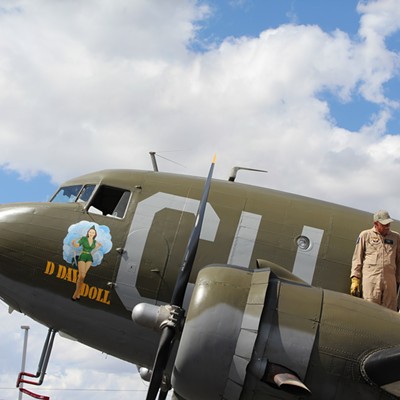The Spanish are going to build a fort that will protect you from the Apaches, so it's naturally time to party. With self-preservation being one of our most basic instincts, that party may develop into something that falls a bit on the carnal side. Welcome to La Fiesta de San Agustín's humble beginnings.
With the excavation of the Presidio we might just choose to honor the dignified majesty of Tucson's history. If we only focus our gaze on what prudes considered puritanically proper, the information would make for a short, if not dry, history lesson.
Most of us know that Tucson developed within the walls of a military garrison affectionately known as the Presidio. Since 1775, a year before the Presidio de San Agustín structure existed, the celebration of Tucson took shape in the Fiesta de San Agustín, so named because of the Convento.
"Whenever the Spanish established a presidio it took on a name of a nearby convent. In this case [the Convento] was San Agustín de Tucson," says Armando Vargas, organizer of La Fiesta de San Agustín.
Missionaries may have celebrated their namesake's feast a day before the Presidio was established, but there is little doubt that it would have been more of a solemn ceremony than the Mardi Gras atmosphere it became.
Historically, "the fiesta would begin on the Saints day" of August 28, says Vargas, when a procession would go out of the church and around the plaza, which is now where the Saint Augustine Cathedral is located. Then the procession would go back into the church.
Outside the church the party would take place and continue 10 or more days, sometimes until the September 16, Mexican Independence Day. "Everyday it would be an ongoing fiesta," says Vargas, beginning in early afternoon, following the siesta, and into the evening.
This fiesta was made up of eating and drinking, but gambling was also a major draw. An 1873 announcement from the Arizona Historical Society's library advertised, "Come ye, all lovers of pleasure, the opportunity is equally good for those persons of speculative turn who aim to combine pleasure with business."
The public was invited to place their bets on cockfighting and horseracing, where the winner could pocket a $300 purse. The community was also treated to sports that now sound peculiar by today's standards. For instance, one common spectator sport entailed betting on which horseman could successfully yank buried chickens out of the earth by the chickens' necks while riding past at high speeds, says Vargas.
According to an announcement published in the Arizona Citizen on August 23, 1873, festivities also included "profane and platonic motors of pleasure" such as orchestral music and "the Theatrical Troupe of Sr. Molina" whose efficiency "as a Comedian is spoken of with great wonder and respect to the art which he has devoted the greater part of his years."
This isn't to say there wasn't room for the pious, however, who would travel from Tucson's church to the churches in San Javier and Magdalena to celebrate the different saints days that were geographically and seasonally associated with St. Augustine's.
But there seems to have been a general attitude that attendees should come to the party and live it up while they could. Of course the announcement sums up this attitude with far greater eloquence by saying, "Should you die after the fiesta is over, be confident that in the empyrean regions, the inhabitants of the mysterious world will surround you and list attentively to the terrene wonders of this happy orb. Be happy in your stay here, and remember we have little of this for our daily repasts ..."
The party ended in the 1920s, however, because of prohibition and the increased hostility towards immigrants that began in the 1840s and 1850s with the rise of what was ironically called the Nativist movement.
Besides inspiring the revival of the Klu Klux Klan in the 1920s, a Nativist sentiment also sparked fears of immigrants working for lower wages, and rested on delusions of Anglo superiority, thus opposed immigration to the U.S. and was particularly anti-Catholic.
It wasn't until the early '80s that two librarians at the Arizona Historical Society decided to reestablish La Fiesta de San Agustín. The Fiesta is now sponsored by the Cultural Exchange Council of Tucson and takes place over a single afternoon during a late August weekend, proving that some parties never die.












